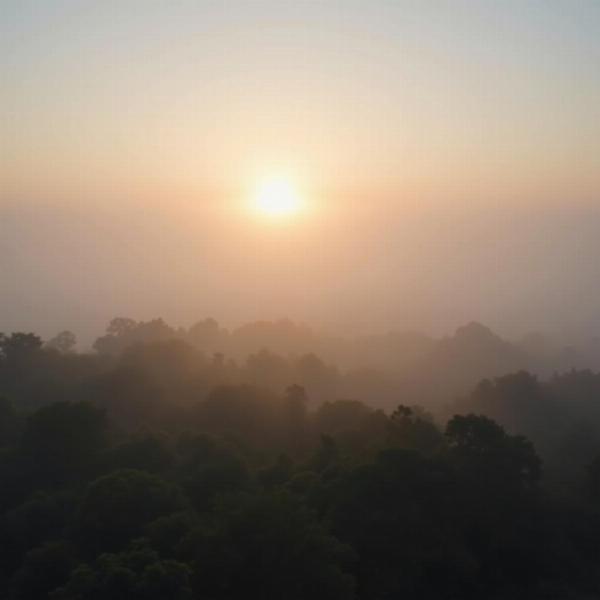Understanding the Hindi meaning of “mist” can be tricky, as various words capture its nuances depending on context and regional variations. Whether you’re a language enthusiast, a translator, or simply curious, this article explores the different ways to express “mist” in Hindi, providing a comprehensive overview of its linguistic and cultural significance.
Decoding “Mist” in Hindi: A Multifaceted Exploration
“Mist” in English refers to a thin layer of water droplets suspended in the air, reducing visibility but less dense than fog. In Hindi, several words convey this meaning, each with subtle differences. Let’s delve into the most common terms:
-
Kohra (कोहरा): This is the most common and widely understood translation for “mist” and often also used for “fog.” It signifies a thicker, denser atmospheric condition that significantly reduces visibility.
-
Dhund (धुंध): Often used interchangeably with kohra, dhund tends to imply a slightly thinner mist, particularly one that forms in the early morning or late evening. It evokes a sense of haziness and obscurity.
-
Kura (कुरा): Primarily used in Northern India, this term denotes a light mist or haze, often associated with cold weather.
-
Paani ki boondein hawa mein latki hui (पानी की बूंदें हवा में लटकी हुई): This descriptive phrase literally translates to “water droplets hanging in the air,” providing a precise explanation of mist’s physical composition.
Regional Variations and Cultural Context
The usage of these terms can vary across different regions of India. For instance, kura might be more prevalent in the northern plains, while dhund is commonly used in other areas. This regional diversity adds richness to the Hindi language. Culturally, mist is often associated with romance, mystery, and the ethereal. Its presence in literature and poetry evokes a sense of ambiguity and mystique.
Hindi Meaning of Mist in Different Scenarios
-
Early Morning Mist: Dhund aptly describes the misty veil that often blankets landscapes in the early hours.
-
Mountain Mist: Kohra is typically used to depict the thick mist that can envelop mountainous regions.
-
Light Mist: Kura or paani ki boondein hawa mein latki hui are suitable for describing a light, almost imperceptible mist.
Why is Understanding the Nuances Important?
Accurate translation requires understanding these nuances. Choosing the correct word ensures the intended meaning is conveyed effectively, avoiding misinterpretations. This is especially crucial in literary translations, technical documents, and any context where precision is paramount.
How does knowing the different terms for “mist” help in translation?
Knowing the different terms allows translators to choose the most appropriate word based on the specific context and intended meaning.
What is the most common word for “mist” in Hindi?
Kohra is the most commonly used word for “mist” in Hindi.
From Mist to Clarity: Finding the Right Word
Selecting the appropriate Hindi word for “mist” depends on the specific context and the desired level of detail. Consider the density of the mist, the time of day, and the regional background to ensure accuracy and clarity in your communication.
 Mist in the morning
Mist in the morning
Conclusion
Understanding the Hindi meaning of “mist” goes beyond simple translation. It involves appreciating the subtle differences between kohra, dhund, kura, and the descriptive phrase paani ki boondein hawa mein latki hui. By recognizing these nuances, you can communicate more effectively and gain a deeper understanding of the Hindi language and Indian culture. The right word can paint a vivid picture and evoke the intended emotion, whether it’s the thick kohra shrouding a mountain or the gentle dhund of an early morning.
FAQ
- What is the difference between kohra and dhund? Kohra generally refers to a thicker fog, while dhund implies a thinner mist, often associated with early mornings or evenings.
- Is there a specific word for mist in mountainous regions? Kohra is commonly used to describe the mist that often blankets mountains.
- What is the literal translation of “mist” in Hindi? The literal translation is paani ki boondein hawa mein latki hui, meaning “water droplets hanging in the air.”
- Which term is used for a light mist? Kura or paani ki boondein hawa mein latki hui are appropriate for describing a light mist.
- Why is it important to understand the nuances of these terms? Understanding the nuances allows for more accurate and effective communication, particularly in translation.
Meaning-Hindi.in is your trusted partner for professional Hindi translation services. We specialize in various domains, including business, legal, technical, website localization, and academic translations. Our team of expert linguists ensures accurate and culturally sensitive translations to meet your specific needs. Contact us today at [email protected] or call us at +91 11-4502-7584 for a free consultation. Meaning-Hindi.in is committed to bridging the language gap and facilitating clear communication.